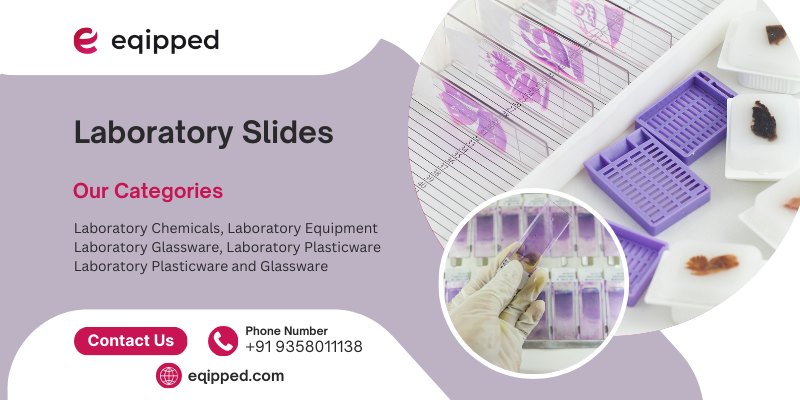Laboratory Slides: Shaping the Future of Science Education

Science is best learned through observation and experimentation. While textbooks provide knowledge, it is hands-on tools that make concepts truly come alive for students. Among these essential tools, laboratory slides play a critical role in education. From biology classrooms in schools to advanced research labs in colleges and universities, slides act as the window to the microscopic world. Their ability to help students and researchers observe, analyze, and understand structures at a cellular or molecular level makes them indispensable in modern science education.
The Importance of Laboratory Slides in Schools
In school science labs, laboratory slides are often a student’s first introduction to the world beyond what the naked eye can see. Young learners get to observe onion cells, cheek cells, and simple microorganisms under the microscope. This experience sparks curiosity and excitement, turning abstract concepts from textbooks into real-life visuals. Laboratory slides make biology lessons more engaging and interactive, helping students remember concepts better. For example, instead of just reading about cell division, students can actually watch the stages of mitosis unfold under the microscope.
Laboratory Slides in College and University Education
At the higher education level, the use of laboratory slides becomes even more sophisticated. College and university students, particularly in life sciences, medicine, and biotechnology, depend heavily on prepared slides for in-depth study. These slides may include tissues, blood samples, bacterial cultures, or even plant structures. Medical students rely on histology slides to understand the human body’s tissues, while microbiology students analyze bacteria or fungi through stained slides. In fields like pathology, laboratory slides serve as vital teaching aids to identify diseases and abnormalities at the microscopic level.
Laboratory Slides and Digital Microscopy: A Modern Trend
One of the most exciting trends in education is the integration of digital microscopy with laboratory slides. With the help of high-resolution digital cameras and computer software, slides can now be projected onto classroom screens. This allows teachers to demonstrate cellular structures to an entire class at once, ensuring every student gets the same detailed view. Digital slides can also be stored, shared, and studied remotely—making them invaluable for online and hybrid learning models that have become increasingly popular in recent years.
Prepared vs. Blank Laboratory Slides: Expanding Learning Opportunities
Schools and colleges often use both prepared slides and blank slides in their laboratories. Prepared slides save time and effort, giving students ready-made specimens to observe. These are especially useful for studying rare or complex tissues that may not be available locally. On the other hand, blank slides allow students to prepare their own specimens, encouraging hands-on involvement. For instance, a simple activity like scraping the inside of the cheek to prepare a slide helps students understand sample preparation, staining techniques, and observation in a single exercise.
Laboratory Slides in STEM Education and Research Projects
The global push for STEM (Science, Technology, Engineering, and Mathematics) education has made laboratory slides even more relevant. Many science fairs, innovation competitions, and student research projects rely on microscopy work. Whether analyzing water samples for microbial contamination or observing plant tissue for agricultural studies, laboratory slides serve as the foundation for practical exploration. Students not only learn scientific techniques but also develop problem-solving and analytical skills that are highly valued in modern careers.
Eco-Friendly and Reusable Laboratory Slides: A Trending Concern
Sustainability has become an important consideration in all aspects of education, including laboratory practices. The trend of using eco-friendly laboratory slides—made from durable, reusable glass or even biodegradable alternatives—is gaining momentum. Colleges and schools are now emphasizing proper cleaning, sterilization, and reuse of slides to reduce waste and costs. Furthermore, manufacturers are developing innovative materials that balance clarity with sustainability, ensuring slides last longer without losing quality.
Safety in Handling Laboratory Slides
While laboratory slides may seem simple, their proper use requires training and safety awareness. Glass slides are fragile and can cause injury if mishandled. Moreover, when biological specimens are involved, proper sterilization and disposal protocols must be followed. Schools and colleges now integrate lab safety sessions where students learn how to prepare, observe, and store slides responsibly. These practices not only ensure safety but also instill professionalism in young learners who may pursue careers in science.
Laboratory Slides in Everyday Learning: Beyond the Classroom
Interestingly, laboratory slides are not restricted to science labs alone. They are increasingly being used in interactive science workshops, science museums, and community outreach programs to inspire the next generation of scientists. For example, workshops that allow children to observe pond water samples on slides often become viral on social media because they highlight the hidden microscopic life around us. This makes laboratory slides not only a teaching tool but also a way to popularize science education globally.
The Future of Laboratory Slides in Education
Looking ahead, the use of laboratory slides is evolving with technological advancements. Virtual reality (VR) and augmented reality (AR) are beginning to merge with digital slide technology, allowing students to explore three-dimensional cellular structures in an immersive environment. Cloud-based slide repositories are being created where students and teachers can access thousands of digital specimens from anywhere in the world. These innovations will continue to expand the role of laboratory slides, making them an even more powerful educational tool for schools and colleges.
Why This Topic Can Go Viral
The topic of laboratory slides has strong viral potential because it connects science education with curiosity and discovery. Social media audiences are often fascinated by microscopy visuals, and short videos showing what students see on slides—like moving microorganisms or intricate plant cells—gain widespread attention. Combined with the ongoing discussion around STEM education, sustainability, and digital learning, laboratory slides remain highly relevant and shareable across platforms.
Conclusion
In conclusion, laboratory slides form the backbone of science education, bridging the gap between theory and observation. In schools, they spark curiosity in young learners, while in colleges and universities, they provide essential insights into biology, medicine, and research. With trends like digital microscopy, sustainability, and immersive technologies reshaping education, the role of slides is expanding rapidly. Laboratory slides are not just simple pieces of glass or plastic—they are tools of discovery, innovation, and inspiration that shape the future of science learning for generations to come.






